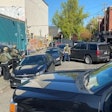California corrections officials have floated a plan that would allow gang members living in high-security housing units to return to the general population as a reward for good behavior.
The California Department of Corrections and Rehabilitation (CDCR) outlined its new policy in a 40-page report, "Security Threat Group Prevention, Identification and Management Strategy." The report, first proposed in 2007, was released on March 9.
Under the new policy, gang members assigned to a Security Housing Unit (SHU) can work their way back to the general population by "demonstrating a willingness and commitment to discontinue gang activity," the report states. The step-down process can take 1-2 years.
California houses roughly 4,000 inmates in the SHU. Once there, inmates are restricted to their cells for 22 1/2 hours a day, allowed little contact with families, and no phone calls, reports KPCC.
Inmates serve six years in the SHU, unless they "debrief" by disassociating themselves with the gang and providing information about gang activity to law enforcement. Under the new program, an inmate could leave the SHU in four years for the less-restrictive "sensitive needs yard" or general population.
If the policy were implemented, corrections officials would "capitulate to their (gang members') wants and needs," said Richard Valdemar, POLICE Magazine's gang expert.
The state currently uses 13 criteria to determine if a prison gang member merits isolation in the SHU. To determine which inmates to assign to the SHU, the CDCR holds hearings to assign inmates with labels such as gang leaders or "associates" based on self admission, tattoos, their associations, crime partners, and other criteria. Also, inmates who present a danger to corrections staff are assigned to the unit.
Members of the Aryan Brotherhood, Black Guerilla Family, Mexican Mafia, Nazi Low Riders, Northern Structure, Nuestra Familia, and Texas Syndicate are considered higher threat, while more subservient gangs include Bloods, Crips, Norteños, Sureños, White Supremacist, and 2-5s.
In July, SHU inmates staged a hunger strike in an attempt to change the restrictive policies.
The CDCR's late-2011 realignment directive to return almost 40,000 state inmates to county jails has eased overcrowding and provided the department "more housing options to support this effort," according to the report.
By Paul Clinton
Related:















